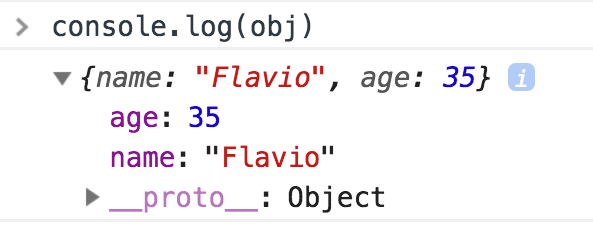How to log an object in Node
New Courses Coming Soon
Join the waiting lists
Logging objects in Node.js
When you type console.log() into a JavaScript program that runs in the browser, that is going to create a nice entry in the Browser Console:

Once you click the arrow, the log is expanded, and you can clearly see the object properties:

In Node, the same happens.
We don’t have such luxury when we log something to the console, because that’s going to output the object to the shell if you run the Node program manually, or to the log file. You get a string representation of the object.
Now, all is fine until a certain level of nesting. After two levels of nesting, Node gives up and prints [Object] as a placeholder:
const obj = {
name: 'Flavio',
age: 35,
person1: {
name: 'Tony',
age: 50,
person2: {
name: 'Albert',
age: 21,
person3: {
name: 'Peter',
age: 23
}
}
}
}
console.log(obj)
{
name: 'Flavio',
age: 35,
person1: {
name: 'Tony',
age: 50,
person2: {
name: 'Albert',
age: 21,
person3: [Object]
}
}
}
How can you print the whole object?
The best way to do so, while preserving the pretty print, is to use
console.log(JSON.stringify(obj, null, 2))
where 2 is the number of spaces to use for indentation.
Another option is to use
require('util').inspect.defaultOptions.depth = null
console.log(obj)
but the problem is that the nested objects after level 2 are now flattened, and this might be a problem with complex objects.
Here is how can I help you:
- COURSES where I teach everything I know
- CODING BOOTCAMP cohort course - next edition in 2025
- BOOKS 16 coding ebooks you can download for free on JS Python C PHP and lots more
- Follow me on X